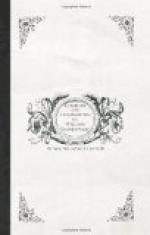Circum praecordia ludit.
The author of the “Imaginary Conversations” seems, in his “Boccacio and Petrarca,” to have taken his idea of Sir Magnus from this manuscript. He, however, has adapted that character to the times; and in Sir Magnus the coward rises to the courageous, the unskilful in arms becomes the skilful, and war is to him a teacher of humanity. With much superstition, theology never molests him; scholarship and poetry are no affairs of his. He doubts of himself and others, and is as suspicious in his ignorance as Sir Thomas is confident.
With these wide diversities, there are family features, such as are likely to display themselves in different times and circumstances, and some so generically prevalent as never to lie quite dormant in the breed. In both of them there is parsimony, there is arrogance, there is contempt of inferiors, there is abject awe of power, there is irresolution, there is imbecility. But Sir Magnus has no knowledge, and no respect for it. Sir Thomas would almost go thirty miles, even to Oxford, to see a fine specimen of it, although, like most of those who call themselves the godly, he entertains the most undoubting belief that he is competent to correct the errors of the wisest and most practised theologian.
EDITOR’S APOLOGY.
A part only of the many deficiencies which the reader will discover in this book is attributable to the Editor. These, however, it is his duty to account for, and he will do it as briefly as he can.
The fac-similes (as printers’ boys call them, meaning specimens) of the handwriting of nearly all the persons introduced, might perhaps have been procured had sufficient time been allowed for another journey into Warwickshire. That of Shakspeare is known already in the signature to his will, but deformed by sickness; that of Sir Thomas Lucy is extant at the bottom of a commitment of a female vagrant, for having a sucking child in her arms on the public road; that of Silas Gough is affixed to the register of births and marriages, during several years, in the parishes of Hampton Lucy and Charlecote, and certifies one death,—Euseby Treen’s; surmised, at least, to be his by the letters “E. T.” cut on a bench seven inches thick, under an old pollard-oak outside the park paling of Charlecote, toward the northeast. For this discovery the Editor is indebted to a most respectable, intelligent farmer in the adjoining parish of Wasperton, in which parish Treen’s elder brother lies buried. The worthy farmer is unwilling to accept the large portion of fame justly due to him for the services he has thus rendered to literature in elucidating the history of Shakspeare and his times. In possession of another agricultural gentleman there was recently a very curious piece of iron, believed by many celebrated antiquaries to have constituted a part of a knight’s breast-plate. It was purchased for two hundred




